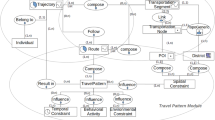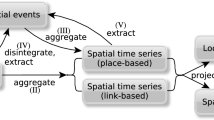Abstract
The General Transit Feed Specification (GTFS) is a data format widely used to share data about public transportation schedules and associated geographic information. GTFS comes in two versions: GTFS Static describing the planned itineraries and GTFS Realtime describing the actual ones. MobilityDB is a novel and free open-source moving object database, developed as a PostgreSQL and PostGIS extension, that adds spatial and temporal data types along with a large number of functions, that facilitate the analysis of mobility data. Loading GTFS data into MobilityDB is a quite complex task that, nevertheless, must be done in an ad-hoc fashion. This work describes how MobilityDB is used to analyze public transport mobility in the city of Buenos Aires, using both, static and real-time GTFS data for the Buenos Aires public transportation system. Visualizations are also produced to enhance the analysis. To the authors’ knowledge, this is the first attempt to analyze GTFS data with a moving object database.






















Similar content being viewed by others
Explore related subjects
Discover the latest articles, news and stories from top researchers in related subjects.Notes
Figure borrowed, with kind permission of the authors, from http://docs.mobilitydb.com/pub/MobilityDB_PGVision2021.pdf.
Notice that the distance is a quadratic function and MobilityDB approximated it with a linear function.
References
Agarwal A (2004) A comparison of weekend and weekday travel behavior characteristics in urban areas. Master thesis, Department of Civil and Environmental Engineering, University of South Florida. https://digitalcommons.usf.edu/cgi/viewcontent.cgi?article=1935&context=etd
Andersen O, Krogh BB, Thomsen C, Torp K (2014) An advanced data warehouse for integrating large sets of GPS data. In: Proceedings of the 17th international workshop on data warehousing and OLAP, DOLAP ’14. ACM, pp 13–22
Bakli MS, Sakr MA, Zimányi E (2019) Distributed moving object data management in MobilityDB. In: Proceedings of the 8th ACM SIGSPATIAL international workshop on analytics for big geospatial data, BigSpatial@SIGSPATIAL 2019. ACM, pp 1:1–1:10
Bast H, Brosi P, Storandt S (2014) Real-time movement visualization of public transit data. In: Proceedings of the 22nd ACM SIGSPATIAL international conference on advances in geographic information systems. ACM, pp 331–340
Behr T, de Almeida VT, Güting RH (2006) Representation of periodic moving objects in databases. In: 14th ACM international symposium on geographic information systems, ACM-GIS 2006, November 10–11, 2006, Arlington. ACM, pp 43–50
Braga M, Santos MY, Moreira AJC (2014) Integrating public transportation data: creation and editing of GTFS data. In: New perspectives in information systems and technologies, vol 2 WorldCIST’14, Advances in Intelligent Systems and Computing, vol 276. Springer, pp 53–62
da Silva MCT, Times VC, de Macêdo JAF, Renso C (2015) SWOT: a conceptual data warehouse model for semantic trajectories. In: Proceedings of the 18th ACM international workshop on data warehousing and OLAP, DOLAP 2015, pp 11–14
de Queiroz ARM, Santos VB, Nascimento DC, Pires CES (2019) Conformity analysis of GTFS routes and bus trajectories. In: XXXIV Simpósio Brasileiro de Banco de Dados, SBBD 2019. SBC, pp 199–204
Fu Z, Tian Z, Xu Y, Qiao C (2016) A two-step clustering approach to extract locations from individual GPS trajectory data. ISPRS Int J Geo-Inf 5(10):166
Güting RH, Schneider M (2005) Moving objects databases. Morgan Kaufmann, San Francisco
Hohmann S, Geistefeldt J (2016) Traffic flow quality from the user’s perspective. Transp Res Proc 15:721–731. International Symposium on Enhancing Highway Performance (ISEHP)
Kaeoruean K, Phithakkitnukoon S, Demissie MG, Kattan L, Ratti C (2020) Analysis of demand-supply gaps in public transit systems based on census and GTFS data: a case study of Calgary, Canada. Public Transp 12(3):483–516. https://doi.org/10.1007/s12469-020-00252-y
Krogh B, Andersen O, Torp K (2012) Trajectories for novel and detailed traffic information. In: Proceedings of the 3rd ACM SIGSPATIAL international workshop on geostreaming, IWGS ’12. ACM, pp 32–39
Kunama N, Worapan M, Phithakkitnukoon S, Demissie MG (2017) GTFS-Viz: tool for preprocessing and visualizing GTFS data. In: Proceedings of the 2017 ACM international joint conference on pervasive and ubiquitous computing and proceedings of the 2017 ACM international symposium on wearable computers, UbiComp/ISWC. ACM, pp 388–396
Leonardi L, Orlando S, Raffaetà A, Roncato A, Silvestri C, Andrienko GL, Andrienko NV (2014) A general framework for trajectory data warehousing and visual OLAP. GeoInformatica 18(2):273–312. https://doi.org/10.1007/s10707-013-0181-3
Meng C, Yi X, Su L, Gao J, Zheng Y (2017) City-wide traffic volume inference with loop detector data and taxi trajectories. In: Proceedings of the 25th ACM SIGSPATIAL international conference on advances in geographic information systems. ACM. https://doi.org/10.1145/3139958.3139984
Parent C, Spaccapietra S, Renso C, Andrienko G, Andrienko N, Bogorny V, Damiani ML, Gkoulalas-Divanis A, Macedo J, Pelekis N, Theodoridis Y, Yan Z (2013) Semantic trajectories modeling and analysis. ACM Comput Surv 45(4):42:1-42:32
Pelekis N, Theodoridis Y (2014) Mobility data management and exploration. Springer, New York. https://doi.org/10.1007/978-1-4939-0392-4
Pelekis N, Theodoridis Y, Vosinakis S, Panayiotopoulos T (2006) Hermes—a framework for location-based data management. In: Proceedings of the 10th international conference on extending database technology, EDBT 2006, Lecture Notes in Computer Science, vol. 3896. Springer, pp 1130–1134
Renso C, Spaccapietra S, Zimányi E (eds) (2013) Mobility data: modeling, management, and understanding. Cambridge University Press, Cambridge
Spaccapietra S, Parent C, Spinsanti L (2013) Trajectories and their representations. In: Renso C, Spaccapietra S, Zimányi E (eds) Mobility data: modeling, management, and understanding. Cambridge University Press, pp 3–22
Vaisman A, Zimányi E (2014) Data warehouse systems: design and implementation. Springer, New York
Vaisman AA, Zimányi E (2019) Mobility data warehouses. ISPRS Int J Geo-Inf 8(4):170
Vuurstaek J, Cich G, Knapen L, Ectors W, Yasar A, Bellemans T, Janssens D (2020) GTFS bus stop mapping to the OSM network. Future Gen Comput Syst 110:393–406
Wei H, Wang Y, Forman G, Zhu Y (2013) Map matching: comparison of approaches using sparse and noisy data. In: Proceedings of the 21st ACM SIGSPATIAL international conference on advances in geographic information systems. ACM, pp 444–447
Wessel N, Widener MJ (2017) Discovering the space-time dimensions of schedule padding and delay from GTFS and real-time transit data. J Geogr Syst 19(1):93–107
Xu J, Güting RH (2013) A generic data model for moving objects. GeoInformatica 17(1):125–172
Yan Z, Chakraborty D, Parent C, Spaccapietra S, Aberer K (2013) Semantic trajectories: mobility data computation and annotation. ACM Trans Intell Syst Technol 4(3):49:1-49:38
Zimányi E, Sakr MA, Lesuisse A (2020) MobilityDB: a mobility database based on PostgreSQL and PostGIS. ACM Trans Database Syst 45(4):19:1-19:42
Acknowledgements
Alejandro Vaisman was partially supported by Project PICT 2017-1054, from the Argentinian Scientific Agency.
Author information
Authors and Affiliations
Corresponding author
Additional information
Publisher's Note
Springer Nature remains neutral with regard to jurisdictional claims in published maps and institutional affiliations.
Rights and permissions
About this article
Cite this article
Godfrid, J., Radnic, P., Vaisman, A. et al. Analyzing public transport in the city of Buenos Aires with MobilityDB. Public Transp 14, 287–321 (2022). https://doi.org/10.1007/s12469-022-00290-8
Accepted:
Published:
Issue Date:
DOI: https://doi.org/10.1007/s12469-022-00290-8




